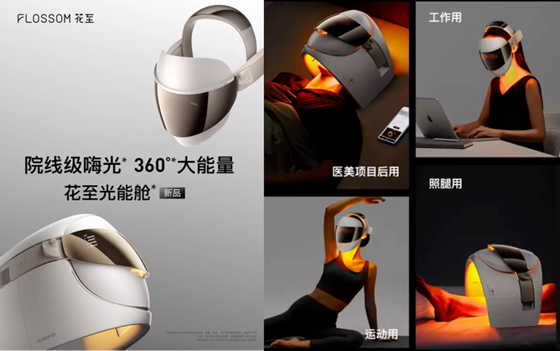In China, as consumer demand for skin care has become increasingly sophisticated and science-based, home-use beauty devices have gradually become an important step in the skin care routine. According to Euromonitor International, 2023’s market size of small personal care appliances in China reached USD5.6 billion, with a CAGR of 4.8% over 2018-2023. Among small personal care appliances, beauty devices witnessed rapid growth, attracting new players.
With the introduction of new regulations for beauty devices in 2024, the market landscape is poised for a significant reshuffle.
Further segmentation in terms of functionality, with LED devices gaining favour
Driven by the trends of the "joyful economy” and the "beauty economy”, Chinese consumers' demand for skin care is shifting towards precise scientific routine. The popularity of content marketing on social media, such as XiaoHongShu and Douyin, has deepened consumers' understanding and accelerated the need for at-home beauty devices. According to Euromonitor International’s Voice of the Consumer: Beauty Survey 2023, Chinese beauty consumers are increasingly embracing beauty tech with a higher usage of all beauty devices, compared to the global average. Brands are also constantly deepening insights into consumer demand by developing segmented skin care functions, such as eye care or jawline lifting.
Amongst the different categories of beauty devices, radiofrequency (RF) devices account for a large proportion of volume sales, but LED devices show strong growth potential. LED beauty devices with various wavelengths address distinct skin concerns, including acne, reducing allergies, skin whitening and brightening. In 2023, 16% of Chinese cosmetics consumers reported sensitive skin issues. Compared to RF options, LED devices are more suitable for sensitive and acne-prone skin with less irritation. Furthermore, when using mask-type LED products, consumers can also safely open their eyes and move their hands freely.
Chinese brand FLOSSOM’s new LED therapy device comes with two modes: dome and mask, retailing for USD680.

Source: FLOSSOM
The combination of beauty device and skin care creates synergies
In China, the self-care trend has gained momentum and beauty consumers, well-versed in aesthetic treatments, are now incorporating beauty devices into their routines as a convenient and long-term solution. A pivotal factor influencing their purchasing decisions is the synergy achieved by using beauty devices in conjunction with skin care products. On social media platforms, influencers play a significant role in promoting these synergies, demonstrating how to maximise efficacy with different combinations.
Furthermore, the market has witnessed an expansion beyond skin care brands to include beauty devices, and vice versa. In 2022, Lancôme unveiled its first beauty device at China Import Expo, which claims to boost the anti-ageing effect by using it together with its serum. Many beauty devices are also offered as bundles with skin care products such as serums and face masks. For instance, Chinese brand QuasarMD highlights the booster effect to attract consumers by offering device and skin care kits.
Premiumisation drives personalisation and multifunctionality
With the gradual diversification of consumer demand for functionality, "smart personalisation" has emerged as a key feature of premium products. Smart beauty devices now not only offer a range of different functions, but also include visual skin analysis through mobile apps and tailored programs addressing various concerns. One notable example is the Chinese brand OGP, which has introduced the concept of intelligent systems in its new “photorejuvenation” device. This device can emit three different wavelengths of photons to target melanin, redness, and dullness, respectively. Users can have their treatment programs customised, including the usage cycle, duration, and recommended wavelengths, all based on skin analysis results through the connected mobile app.
How to combine technology with seamless user experience while addressing consumers’ evolving skin care needs will become the long-term exploration goal for beauty device players.
New regulation for beauty devices to reshuffle the landscape
Currently, at-home beauty devices in China are considered small appliances and are regulated by the relevant industry standards, which lack the process of clinical verification. Issues relating to radiofrequency (RF) beauty devices are increasing, including exaggerated claims and false advertising. To better regulate RF beauty devices, the National Medical Products Administration issued the "Radiofrequency Beauty Device Registration Review Guidelines" where RF devices will be regulated as Class III medical devices, which is the highest-risk level of medical devices. As of 1 April 2024, the production, import, and sale of RF beauty devices will be prohibited unless medical device registration is obtained.
The new regulation is expected to change the current competitive landscape of RF beauty devices, and long-tail brands without qualification will be eliminated. With this stringent regulation, the threshold for RF beauty devices will increase, and the unit price is likely to rise. Leading local Chinese brands, such as Flossom, Yaman, OGP, and AMIRO, have already begun their clinical trials. In the future, innovative beauty devices that are truly effective are likely to win the market.
Beauty devices have witnessed remarkable growth. With advancing consumer knowledge and increasing demand for upgraded beauty devices, as well as the new regulations further standardising the market, the overall competition will gradually shift from pricing to product innovation and scientific validation.
Read our report Personal Care Appliances in China and Beauty and Personal Care in China for further analysis on the drivers of science-based personal care in China.

